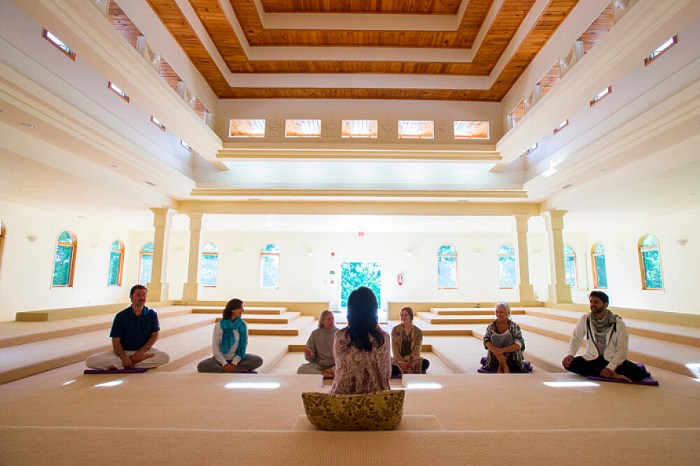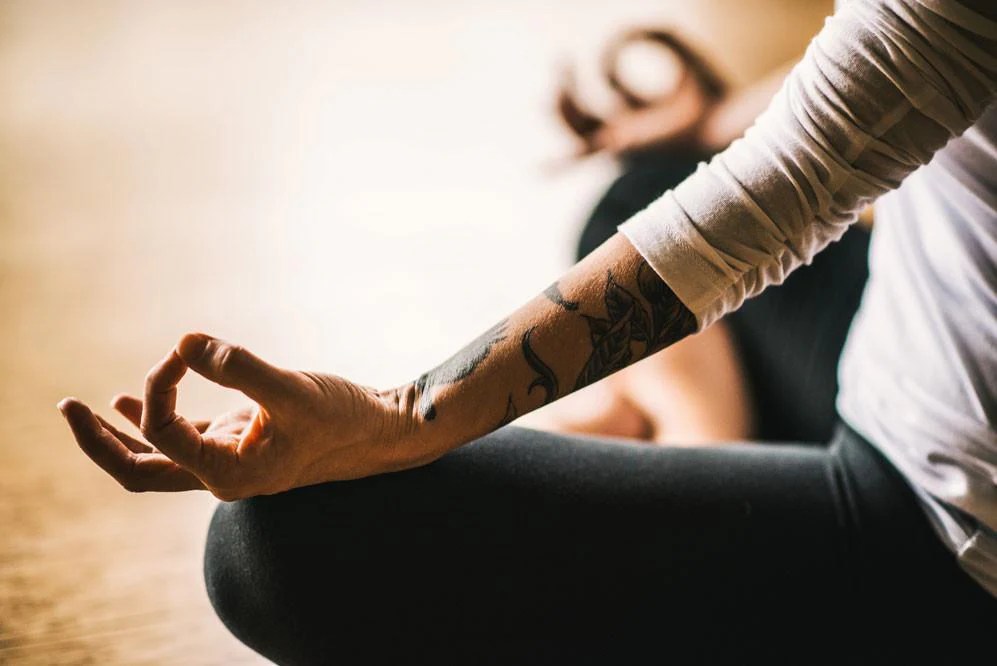Embark on a journey through 10 Simple Techniques for Starting Meditation, where you will uncover the foundational practices to cultivate mindfulness and tranquility. This comprehensive guide delves into the essence of meditation for beginners, offering insights and practical tips to kickstart your meditation journey.
Explore the different facets of meditation, from mindfulness and breathing techniques to visualization and mantra meditation, as you discover the transformative power of a consistent meditation practice.
Overview of Meditation Techniques

Meditation is a powerful practice that can bring numerous benefits to your mind, body, and spirit. For beginners, it’s important to start with simple techniques to ease into the practice and build a strong foundation. Here are 10 simple meditation techniques to get you started and reap the benefits of a regular meditation practice.
Mindful Breathing
- Focus on your breath as it goes in and out
- Notice the sensations in your body as you breathe
- Bring your mind back to your breath whenever it wanders
Body Scan Meditation
- Progressively relax each part of your body from head to toe
- Release tension and stress as you scan through each body part
- Bring awareness to any areas of discomfort and breathe into them
Loving-Kindness Meditation
- Send love and compassion to yourself
- Extend that love to others in your life
- Practice forgiveness and kindness towards all beings
Mantra Meditation
- Repeat a simple phrase or word silently or aloud
- Focus on the sound and vibration of the mantra
- Let go of other thoughts as you repeat the mantra
Visualization Meditation
- Imagine a peaceful place or scenario in your mind
- Engage all your senses in the visualization
- Feel the emotions and sensations of being in that peaceful place
Walking Meditation
- Focus on each step as you walk mindfully
- Feel the ground beneath your feet and the movement of your body
- Stay present and aware of your surroundings as you walk
Body Movement Meditation
- Engage in gentle movements like yoga or tai chi
- Focus on the sensations in your body as you move
- Connect your movement with your breath for a meditative experience
Sound Meditation
- Listen to calming music or nature sounds
- Focus on the different layers of sound and how they make you feel
- Let the sound wash over you and bring you into a state of relaxation
Guided Meditation, 10 Simple Techniques for Starting Meditation
- Follow along with a guided meditation recording or app
- Allow the narrator to lead you through relaxation and visualization exercises
- Explore different guided meditations to find what resonates with you
Empty Mind Meditation
- Let go of all thoughts and simply be in the present moment
- Focus on the space between your thoughts
- Experience a sense of peace and clarity in the silence of your mind
Mindfulness Meditation
Mindfulness meditation is a practice that involves focusing your mind on the present moment, acknowledging and accepting your thoughts and feelings without judgment. It can help reduce stress, improve concentration, and promote emotional well-being.
How to Practice Mindfulness Meditation
- Find a quiet and comfortable place to sit or lie down.
- Close your eyes and take deep breaths, focusing on the sensation of breathing.
- Bring your attention to the present moment, observing your thoughts and feelings without getting caught up in them.
- Notice any physical sensations in your body, such as tension or relaxation.
- Continue to breathe deeply and stay present in the moment for a few minutes.
Real-Life Examples of the Impact of Mindfulness Meditation
Mindfulness meditation has been shown to reduce symptoms of anxiety and depression in various studies.
- A study conducted by Harvard Medical School found that mindfulness meditation can help improve focus and cognitive function.
- In a workplace setting, employees who practiced mindfulness meditation reported higher levels of job satisfaction and lower stress levels.
- Many professional athletes incorporate mindfulness meditation into their training routines to enhance performance and mental resilience.
Breathing Techniques
Breathing techniques play a crucial role in meditation practices as they help to calm the mind, increase focus, and promote relaxation. By focusing on the breath, individuals can cultivate a greater sense of awareness and presence in the moment.
Diaphragmatic Breathing
- Also known as belly breathing, diaphragmatic breathing involves deep inhalation through the nose, allowing the belly to rise as the diaphragm expands.
- Exhalation is then done slowly through the mouth, allowing the belly to fall as the diaphragm contracts.
- This technique helps to activate the body’s relaxation response, reducing stress and promoting a sense of calm.
Counted Breathing
- In counted breathing, individuals focus on counting the duration of their inhalations and exhalations, such as inhaling for a count of four and exhaling for a count of six.
- This technique helps to regulate breathing patterns, slow down the heart rate, and quiet the mind.
- Counted breathing can be particularly effective in reducing anxiety and increasing mindfulness.
Alternate Nostril Breathing
- This technique involves breathing in through one nostril, holding the breath briefly, and then exhaling through the other nostril, alternating between the two.
- Alternate nostril breathing helps to balance the flow of energy in the body, calm the nervous system, and enhance mental clarity.
- Practicing this technique can promote a sense of balance and harmony within the body and mind.
Setting the Right Environment
Creating the perfect environment for meditation is crucial for a successful practice. The right setting can help you focus, relax, and achieve a deeper state of mindfulness.
Role of Lighting and Sound
When setting up your meditation space, consider the role of lighting and sound. Soft, natural lighting can create a calming atmosphere, while soothing sounds like nature sounds or white noise can help drown out distractions. Experiment with different lighting and sounds to find what works best for you.
Finding a Peaceful Space
To find a peaceful space for meditation, look for a quiet area free from distractions. This could be a corner of a room, a cozy nook by a window, or even a spot in your backyard. Make sure the space is clean and clutter-free to promote a sense of calm and tranquility.
Body Scan Meditation

Body scan meditation is a technique that involves focusing on different parts of the body to bring awareness to physical sensations, tension, and relaxation. The purpose of body scan meditation is to cultivate mindfulness and promote relaxation by tuning into the body’s signals and releasing any built-up tension or stress.
Step-by-Step Guide to Body Scan Meditation
- Find a comfortable and quiet space to sit or lie down.
- Close your eyes and take a few deep breaths to center yourself.
- Start by bringing your attention to your toes, noticing any sensations without judgment.
- Slowly move your focus up through each part of your body, one at a time, from your feet to your head.
- As you scan each body part, observe any tension or discomfort, and consciously release it with each exhale.
- Take your time and stay present in the moment, allowing yourself to fully experience each sensation.
- Finish the body scan by taking a few more deep breaths and slowly opening your eyes.
Benefits of Body Scan Meditation for Beginners
- Enhances body awareness and connection.
- Promotes relaxation and stress relief.
- Helps in releasing physical tension and discomfort.
- Improves focus and concentration.
- Encourages mindfulness and being present in the moment.
Visualization Meditation

Visualization meditation involves the practice of creating mental images or scenarios to focus the mind and promote relaxation. By visualizing specific images or scenes, individuals can enhance their ability to concentrate, reduce stress, and cultivate positive emotions.
Examples of Visualization Techniques for Beginners
- Beach Visualization: Imagine yourself lying on a sandy beach, listening to the sound of the waves, feeling the warmth of the sun on your skin, and smelling the salty ocean breeze.
- Forest Walk Visualization: Picture yourself walking through a lush forest, surrounded by tall trees, chirping birds, and the earthy scent of the forest floor.
- Candle Flame Visualization: Envision a flickering candle flame in a dark room, focusing on the movement of the flame and allowing your mind to follow its gentle sways.
Role of Imagination in Visualization Meditation
Visualization meditation relies on the power of imagination to create vivid mental images that evoke feelings of calmness, joy, and tranquility. By engaging the creative faculties of the mind, individuals can harness the benefits of visualization to deepen their meditation practice and enhance overall well-being.
Walking Meditation: 10 Simple Techniques For Starting Meditation
Walking meditation is a form of meditation that involves focusing on the act of walking and being fully present in the moment. It combines the physical activity of walking with mindfulness practice, allowing individuals to cultivate awareness and peace of mind while moving.
How to Practice Walking Meditation Effectively
- Find a quiet and peaceful place to walk, preferably outdoors in nature.
- Start by standing still and taking a few deep breaths to center yourself.
- Begin walking at a slow and steady pace, focusing on each step you take.
- Pay attention to the sensations in your body as you walk, such as the feeling of your feet touching the ground.
- Stay present and mindful, letting go of any distractions or wandering thoughts.
- Continue walking for a designated period of time, allowing yourself to fully experience the practice.
Comparison with Traditional Sitting Meditations
- Walking meditation offers a different experience than traditional sitting meditations like mindfulness or visualization.
- It provides a way to incorporate movement and physical activity into your mindfulness practice.
- Some people find it easier to stay present and focused while walking, as the movement helps anchor their attention.
- Walking meditation can be a great option for those who struggle with sitting still for long periods or have physical discomfort from sitting.
Mantra Meditation
In mantra meditation, practitioners repeat a specific word, phrase, or sound to help focus the mind and enter a meditative state. This technique can be especially beneficial for those who find it challenging to quiet the mind and stay present during meditation.
Popular Mantras for Beginners
- Om: Considered the most sacred mantra in Hinduism and Buddhism, Om represents the sound of the universe and can help connect with a higher power.
- So Hum: This mantra translates to “I am that” in Sanskrit, emphasizing the connection between oneself and the universe.
- Peace: A simple yet powerful mantra that can promote feelings of calmness and tranquility.
- Love: Focusing on the mantra “love” can help cultivate feelings of compassion and kindness towards oneself and others.
Significance of Repetitive Chanting
Repeating a mantra during meditation serves to anchor the mind and prevent distractions. The rhythmic and repetitive nature of chanting a mantra helps quiet the internal chatter of the mind, allowing practitioners to experience a sense of peace and clarity. Over time, the mantra becomes deeply ingrained in the subconscious, leading to a natural state of mindfulness and presence throughout the day.
Incorporating Meditation into Daily Routine
To make meditation a regular part of your daily routine, it’s essential to find ways to seamlessly integrate it into your schedule. Consistency is key to reaping the full benefits of meditation, so overcoming obstacles and establishing a routine is crucial.
Tips for Integrating Meditation into Your Daily Routine
- Set a specific time each day for meditation, whether it’s in the morning before starting your day or in the evening before bed.
- Start with short meditation sessions and gradually increase the duration as you become more comfortable with the practice.
- Choose a quiet and peaceful space where you can meditate without distractions.
- Use reminders or alarms on your phone to prompt you to meditate at the designated time.
- Combine meditation with other daily activities, such as incorporating mindfulness while eating or taking short meditation breaks during work.
Overcoming Common Obstacles in Maintaining a Meditation Practice
- Acknowledge that it’s normal to have racing thoughts or find it difficult to focus during meditation sessions.
- Experiment with different meditation techniques to find the ones that resonate most with you.
- Be patient with yourself and understand that progress in meditation takes time and consistency.
- Don’t be too hard on yourself if you miss a day of meditation; simply pick up where you left off the next day.
Importance of Consistency in Establishing a Meditation Routine
- Consistency is key to experiencing the full benefits of meditation, such as reduced stress, improved focus, and enhanced overall well-being.
- Regular meditation practice helps train the mind to be more present and aware in everyday life.
- Establishing a consistent meditation routine creates a sense of structure and discipline in your daily life.
- By making meditation a regular habit, you are more likely to prioritize self-care and mental well-being.
Progress and Growth in Meditation Practice

Starting a meditation practice is just the beginning of a journey towards personal growth and self-discovery. As beginners embark on this path, it’s essential to track their progress and find ways to deepen their practice over time. Consistent meditation can lead to profound changes in one’s mindset, emotional well-being, and overall outlook on life.
Tracking Progress in Meditation
- Keep a meditation journal to record thoughts, feelings, and experiences before and after each session.
- Use meditation apps or timers to track the duration of your practice and set goals for increasing the length of your sessions.
- Notice subtle changes in your mental and emotional state throughout the day, such as increased awareness, reduced stress, or improved focus.
Deepening the Meditation Practice
- Experiment with different meditation techniques to find what resonates with you and brings the most profound benefits.
- Attend meditation retreats or workshops to immerse yourself in a supportive environment and learn from experienced teachers.
- Challenge yourself to meditate in more challenging environments or for longer periods to push past mental barriers and deepen your practice.
Personal Growth Through Meditation
- Develop a greater sense of self-awareness and emotional intelligence through regular meditation practice.
- Experience increased compassion, empathy, and connection with others as you cultivate a more present and open-hearted mindset.
- Witness positive changes in your relationships, work performance, and overall sense of fulfillment as you continue to deepen your meditation practice over time.
Ending Remarks

In conclusion, 10 Simple Techniques for Starting Meditation serves as a gateway to a more centered and harmonious way of living. By incorporating these techniques into your daily routine, you can enhance your overall well-being and embark on a path of self-discovery and personal growth. Start your meditation journey today and unlock the profound benefits that meditation has to offer.